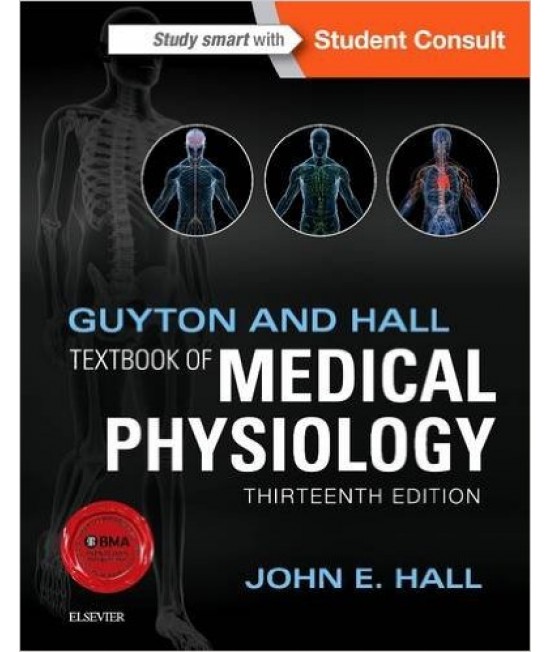Guyton and Hall Textbook of Medical Physiology, 13th Edition
- 199.00лв.
- без ДДС: 165.83лв.
- Наличност:Няма наличност
- Производител: Elsevier
- Модел: 978-1-4557-7005-2
The 13th edition of Guyton and Hall Textbook of Medical Physiology continues this bestselling title's long tradition as the world’s foremost medical physiology textbook. Unlike other textbooks on this topic, this clear and comprehensive guide has a consistent, single-author voice and focuses on the content most relevant to clinical and pre-clinical students. The detailed but lucid text is complemented by didactic illustrations that summarize key concepts in physiology and pathophysiology.
CONTENTS
I. Introduction to Physiology: The Cell and General Physiology
1. Functional Organization of the Human Body and Control of the "Internal Environment"
2. The Cell and Its Functions
3. Genetic Control of Protein Synthesis, cell function, and cell reproduction
II. Membrane Physiology, Nerve, and Muscle
4. Transport of Substances Through Cell Membranes
5. Membrane Potentials and Action Potentials
6. Contraction of Skeletal Muscle
7. Excitation of Skeletal Muscle: Neuromuscular Transmission and Excitation-Contraction Coupling
8. Excitation and Contraction of Smooth Muscle
III. The Heart
9. Cardiac Muscle; The Heart as a Pump and Function of the Heart Valves
10. Rhythmical Excitation of the Heart
11. The Normal Electrocardiogram
12. Electrocardiographic Interpretation of Cardiac Muscle and Coronary Blood Flow Abnormalities: Vectorial Analysis
13.Cardiac Arrhythmias and Their Electrocardiographic Interpretation
IV. The Circulation
14. Overview of the Circulation; Biophysics of Pressure, Flow, and Resistance
15. Vascular Distensibility and Functions of the Arterial and Venous Systems
16. The Microcirculation and Lymphatic System: Capillary Fluid Exchange, Interstitial Fluid, and Lymph Flow
17. Local and Humoral Control of Tissue Blood Flow
18. Nervous Regulation of the Circulation and Rapid Control of Arterial Pressure
19. Role of the Kidneys in Long-Term Control of Arterial Pressure and in Hypertension: The Integrated System for Aterial Pressure Regulation
20. Cardiac Output, Venous Return, and Their Regulation
21. Muscle Blood Flow and Cardiac Output During Exercise; the Coronary Circulation and Ischemic Heart Disease
22. Cardiac Failure
23. Heart Valves and Heart Sounds; Valvular and Congenital Heart Defects
24. Circulatory Shock and Its Treatment
V. The Body Fluids and Kidneys
25. The Body Fluid Compartments: Extracellular and Intracellular Fluids; Edema
26. The Urinary System: Functional Anatomy and Urine Formation by the Kidneys
27. Glomerular Filtration, Renal Blood Flow, and Their Control
28. Renal Tubular Reabsorption and Secretion
29. Urine Concentration and Dilution; Regulation of Extracellular Fluid Osmolarity and Sodium Concentration
30. Renal Regulation of Potassium, Calcium, Phosphate, and Magnesium; Integration of Renal Mechanisms for Control of Blood Volume and Extracellular Fluid Volume
31. Acid-Base Regulation
32. Diuretics, Kidney Diseases
VI. Blood Cells, Immunity, and Blood Coagulation
33. Red Blood Cells, Anemia, and Polycythemia
34. Resistance of the Body to Infection: I. Leukocytes, Granulocytes, the Monocyte-Macrophage System, and Inflammation
35. Resistance of the Body to Infection: II. Immunity and Allergy
36. Blood Types; Transfusion; Tissue and Organ Transplantation
37. Hemostasis and Blood Coagulation
VII. Respiration
38. Pulmonary Ventilation
39. Pulmonary Circulation, Pulmonary Edema, Pleural Fluid
40. Principles of Gas Exchange; Diffusion of Oxygen and Carbon Dioxide Through the Respiratory Membrane
41. Transport of Oxygen and Carbon Dioxide in Blood and Tissue Fluids
42. Regulation of Respiration
43. Respiratory Insufficiency - Pathophysiology, Diagnosis, Oxygen Therapy
VIII. Aviation, Space, and Deep-Sea Diving Physiology
44. Aviation, High Altitude, and Space Physiology
45. Physiology of Deep-Sea Diving and Other Hyperbaric Conditions
IV. The Nervous System: A. General Principles and Sensory Physiology
46. Organization of the Nervous System, Basic
| Харектеристики | |
| Автор(и) | John E. Hall, PhD |
| Издател | Elsevier |
| Издание | 13th Edition |
| Година на издаване | June 3, 2015 |
| Размер | 222 x 283 / 44 mm |
| Обем | 1168 pages |
| Тип корица | Hardcover |
| Език | English |

